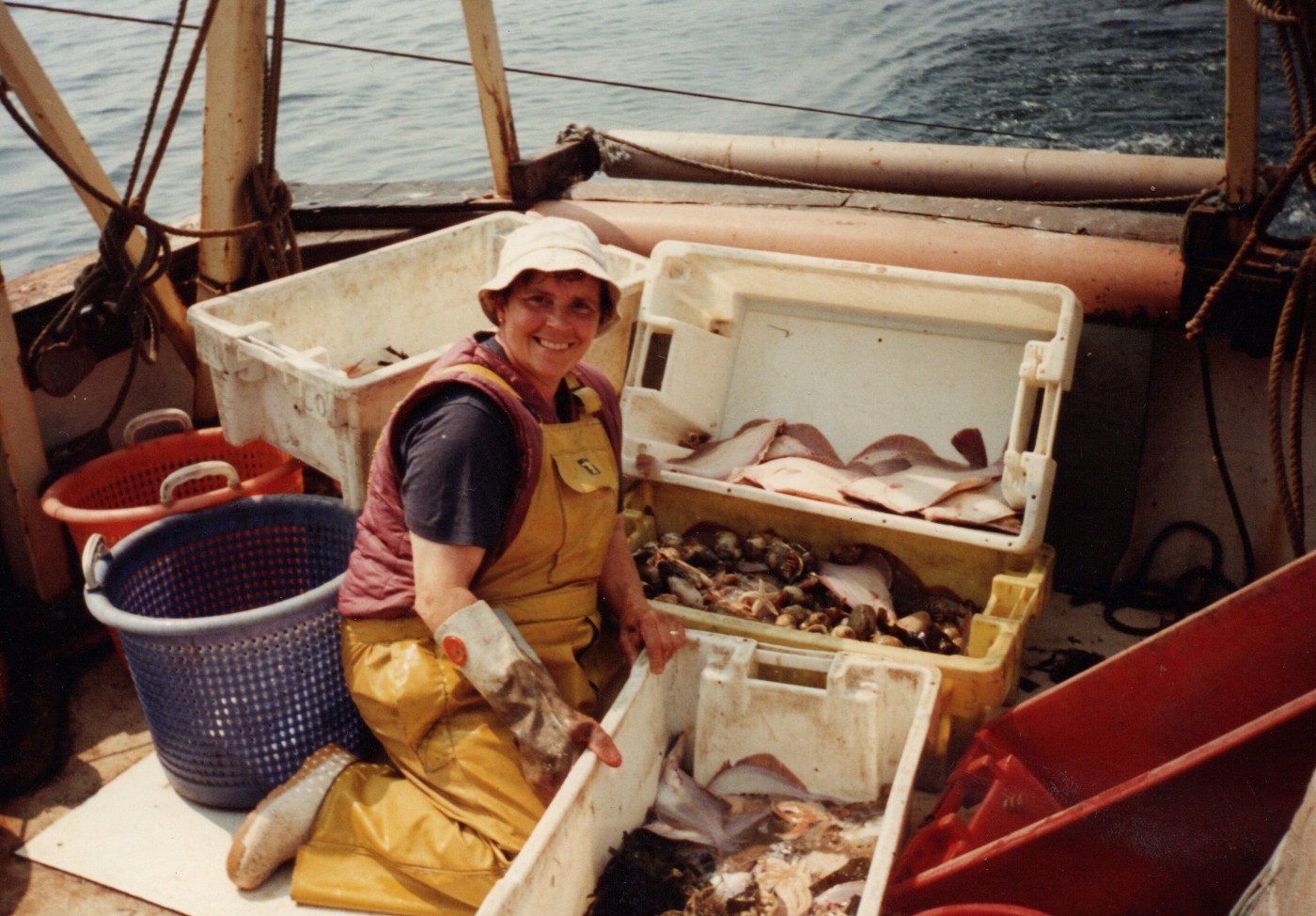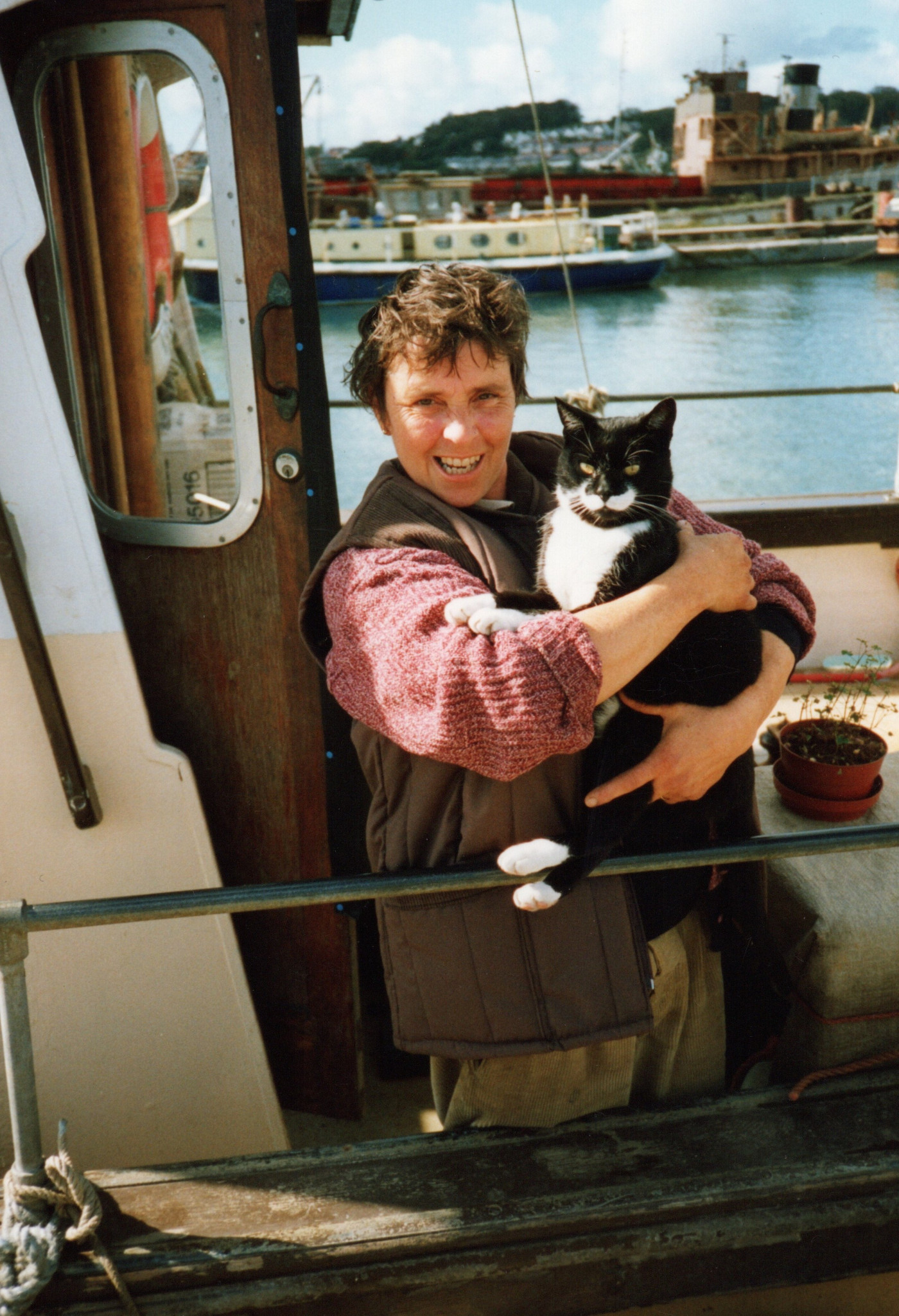This article was written for the Rewriting Women into Maritime inititative by Richard Wemyss, Chair of Cellardyke Trust and the Manx Beauty Project.
Sylvia Sharples (1942-2023)
Deckhand and Co-owner of Fishing Trawler
Sylvia Sharples was not born to the sea but came to love and work aboard a fishing vessel in her thirties. She had taken on a guesthouse in Port Penrhyn in North Wales in 1973. Occasionally she arranged for guests to be taken out on angling trips aboard the Manx Beauty, a 1937 wooden fishing vessel, and she befriended the skipper. This was a particularly difficult time for her, and in 1975 her marriage broke down. She asked Skipper Arthur Maddock if she could move onto the boat as a temporary measure.

Sylvia Sharples on board Mistress II c.1991-1992, © Courtesy of The Cellardyke Trust
The Manx Beauty at first was a place of sanctuary, she left a house and family to move in aboard, and this developed into a relationship. It was no romantic sail into the sunset, it was hard graft, leaving everything she knew behind.
“I learned a lot about life, boat terminology, net mending, gutting fish, mending engines and coping with emergencies, as the skipper said “money is no good out at sea, there’s no hard shoulder, it’s up to us to sort it out”. The sea is one of the greatest things to sort the men out from the boys. You have to be real shipmates to spend 24/7 with each other living together in a small cabin, and be self-sufficient. A generator provided the electricity, water was carried in a five-gallon container, and you were always on duty even in port, when bad weather was around. In bad winters when the ice formed you had to keep an area round the boat free or it would crush the wooden planks. Sometimes tree trunks or large pieces of timber came in with the tide. These had to be fended off.
I soon found another philosophy on life – my priorities were different from the rat race I had been in. It was a huge learning curve, no fancy clothes, no make-up, everything had to be sensible.

The Manx Beauty at Port Penrhyn, © Courtesy of The Cellardyke Trust
The day would be about 14 or 16 hours long before I could get to the foc’sle to wash and make a meal, inevitably our own fish, nothing ever tasted so good. We would then talk over the day’s events, have a couple of glasses of cider, wait for the shipping forecast around midnight go to bunk again for an early start, weather permitting. Then the process would start all over again.
The trip to the fishing grounds would take about 2 hours. One hour from port to Puffin Island off the coast of Anglesey, distance about six miles against the incoming tide. It would take another hour to reach the fishing grounds. The skipper would now be thinking where next to shoot the gear, me the deck hand would stow all the things in the foc’sle, the galley and on deck ready for action. It was time to go down to the galley to make tea and toast for breakfast, not knowing when we would next eat. It depended how much fish was in the first haul.
At the fishing grounds the net was shot and the first tow started. The next two hours seemed to drag. During this time, the engine was checked and the bilges for any leaks. The engine room is only about 3ft 6inches high and smells of oil and diesel and is very hot.
Time up and ready to haul, oilskins donned, winch started, and slowly the gear came up, once the net was up to the blocks the stern of the boat was turned so the cod end was alongside amidships. Ropes were pulled tight to keep the fish in and the lifting strop fixed to the gilson to heave the bag aboard. It was suspended just above the deck so the cod string could be opened to let the fish onto the deck.
The cod end was tied and blessed (a quick spit) and the boat was straightened ready to shoot again.”
Sylvia and Arthur lived aboard the Manx Beauty with no shore base until 1983 when Arthur, 28 years her senior, passed away. She believed herself to have been the first registered female working shareholder of a fishing vessel, they had lived and worked together for almost 18 years.

Sylvia Sharples on board Mistress II with cat, Jingle, © Courtesy of The Cellardyke Trust
“Our main payment was the way of life and happiness at doing something you enjoyed, despite the hardships. Money passed through your hands like quicksilver. We ate fish “8 days a week” and lived mainly on smoked fish during the winter. All money had to be earned between March and November. The fish are migratory and you would have to travel many miles to make a living. Winter time was spent getting the nets ready for the next season, overhauling the rigging, engine servicing and keeping healthy. You had to be tough."
Back to the exhibition home page.

